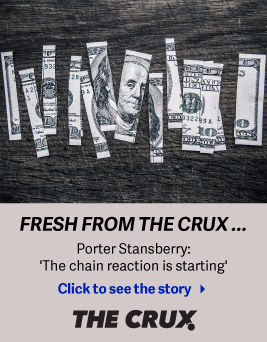| Home | About Us | Resources | Archive | Free Reports | Market Window |
The Basics of Gold, From the Man Who Has the GoldBy
Monday, October 5, 2015
If he who has the gold makes the rules, then Rudi Fronk makes the rules...
Rudi Fronk is CEO, chairman, and founder of Seabridge Gold, a company that has roughly $43 billion of gold in the ground (and $23 billion of copper) at its KSM project in Canada, near the Alaska border.
Rudi is a longtime friend of ours. Subscribers of mine made an extraordinary 995% in shares of Seabridge Gold from 2005 to 2009. Rudi will be speaking at our Stansberry Conference Series next week in Las Vegas (details here).
He is always optimistic on gold. Now that gold has fallen from a high of $1,900 to current levels near $1,130, we thought we'd check in with him to get a refresher on why you need to own some today...
Steve: Rudi, you think of gold as more than just a metal. Why do you consider gold a true form of money, or a currency in itself?
Rudi: Gold is the world's only universally accepted form of final settlement. Unlike all other assets, it backs itself because it is no one's obligation. Bonds and stocks represent claims on assets and the value of these claims depends on the issuers making good on their promises. Gold does not.
The one who possesses gold has more effective control of his wealth than the holder of currency or financial assets, all of which are subject to default. By the end of World War II, nearly half of the world's currencies had gone to zero during the conflict and its immediate aftermath.
Gold has no central bank and no government that stands behind it and profits from its manipulation.
Steve: Gold prices soared during the 2000s. But they've now fallen 41% since peaking in 2011. Why do you expect prices to rise from here?
Rudi: This is just simple math...
All the gold in the world today is worth about $6 trillion. Total debt exceeds $200 trillion while world gross domestic product (GDP) is about $50 trillion. The holders of that debt assume they are holding real wealth but their assets depend upon the ability and willingness of borrowers to repay the debt.
The amount of the debt is not sustainable. Only the issue of further debt keeps the game going. When the music stops, the $200 trillion in paper wealth will try to squeeze into the $6 trillion in gold to protect itself with the only asset that cannot default.
Steve: My colleague Porter Stansberry believes the value of gold never changes. It's simply the whims of investors that determines today's price in a given currency. Do you agree?
Rudi: Sure. The argument can be made that the price of gold has not changed in several thousand years. Currencies go up and down against gold as they gain and lose confidence, but gold is the constant.
Gold is to value what a yard is to length or a pound is to weight... a universally accepted measure, a numeraire. Very recently, gold's role as the ultimate measure of value has been forced into the shadows, but it will re-emerge when investors recognize that the inability to print it makes it far more reliable than paper currencies and the governments that back them.
The gold standard has not gone away; it has been privatized. You can go on your own gold standard by owning gold and gold stocks to hedge a portion of your wealth. The 300 year average for increasing the world's supply of gold is 1.5% per year. No government has ever failed to grow fiat currencies at multiples of that rate.
Steve: Rudi, thanks for your time. I look forward to catching up again in Las Vegas.
.jpg) Rudi has made a fantastic career in the gold mining and exploration industry. And he knows as much, or more, about the metal than anyone I've ever met. He'll be sharing this knowledge at our upcoming Stansberry Conference Series event in Las Vegas next week. I hope you're planning to attend. But if not, you can still hear everything Rudi has to say, as well as hear from the rest of our presenters.
We're currently offering live-streaming access to this event. If you're interested, you can find all of the details here.
Good investing,
Steve
Further Reading:
Dr. David "Doc" Eifrig has shown readers how powerful it can be to hold "chaos hedges" – like gold – in your portfolio... "When investors get nervous about bad economic news... debt crises in Europe... and the specter of runaway inflation in the United States," he writes, "stocks fall, and gold and silver rise." Learn how Doc protects his wealth with precious metals here and here.
In this must-read essay, Dan Ferris explains how owning physical gold and silver preserves the purchasing power of your wealth. The Fed is "an imbecile with a hammer. The hammer is money-printing, and every economic problem is a nail. So you should always own gold..."
Market NotesNEW HIGHS OF NOTE LAST WEEK
Not many... the S&P 500 is down 10% since mid-August
NEW LOWS OF NOTE LAST WEEK
Hess (HES)... Big Oil
Sunoco (SUN)... oil refining
Kinder Morgan (KMI)... oil pipelines
Vale (VALE)... diversified miner
Goldcorp (GG)... gold stock
Rayonier (RYN)... timberland
Potash (POT)... fertilizer
Mosaic (MOS)... fertilizer
Goldman Sachs (GS)... investment bank
Morgan Stanley (MS)... financial services
Hewlett-Packard (HPQ)... Big Cheap Tech
3D Systems (DDD)... 3D printing
Xerox (XRX)... office technology
Abbott Laboratories (ABT)... Big Pharma
Macy's (M)... retailer
Hyatt Hotels (H)... hotels
Coach (COH)... luxury handbags
Time Warner (TWX)... entertainment
CBS (CBS)... media
Regal Entertainment (RGC)... movie theaters
|
Recent Articles
|



